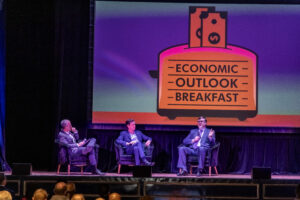In November 2024, HK Architects hosted its 25th anniversary celebration. Quite fittingly, the party was held at Wheelhouse, HK’s headquarters, a perfect example of the way HK design incorporates community building and adaptive re-use planning.
HK’s story is remarkable, a microcosm running parallel with the last 25 years in Chattanooga. Spin a compass in any direction and you’ll be hard-pressed to find one area of downtown Chattanooga not impacted, influenced or shaped by Heidi Hefferlin, Craig Kronenberg and their HK team.
The Riverfront. Southside. UTC. Warehouse Row. US Xpress. Patten Towers and Mill Town. The Chattanooga Bank Building. Southside. Cameron Harbor. Just to name a few.
HK’s team helped design the bus stops for our city’s electric shuttle, encouraged the relocation of artists by creating live-work studios, designed some of our region’s most enduring, stunning residential homes.
““HK is integral to our city’s fabric,” said Alex Reyland, principal.
It began in the early 1990s, the infant years of our downtown renaissance. Heidi Hefferlin was living and working in LA when her phone rang. It was her sister, Melissa, who’d moved back to Chattanooga.
The city’s changing. It will need architects. Come back home,
Heidi took her sister’s advice. She and husband Craig Kronenberg – both established architects globally – moved back to Chattanooga, not far from the Hefferlin home place in Apison.
Heidi and Craig started small: residential redesign, working out of the basement of their Signal Mountain home.
One day, Heidi was talking with a client – in her attic, of all places, as part of the redesign – when the client offered an insightful question:
Why don’t you start your own firm?
It was the nudge she needed. Soon, Heidi and Craig moved HK Architects to Main Street, then, moved further into the Southside, at a time when most downtown urban attention was elsewhere.
They purchased a Chattanooga Neighborhood Enterprise home, relocating their family from Signal Mountain, then purchasing and leasing to others. They designed live-work studios for artists, like the Lay Low while securing grants, planting trees, designing a neighborhood park near Battle Academy.
They created a neighborhood association, installed signage, street toppers and authored projects, conversations, encouragements large and small – all the things needed to make a community thrive.
“The influence we had on the Southside is probably the contribution we are both proudest of,” said Craig.
Merging a philosophy of building community through approachable, beautiful architecture and design, HK offered real places for artists and families while bringing attention and industry to the Southside.
“It is so gratifying to see people engaging with their environment,” said Heidi. “We did something well that’s sustainable. We were building things that were going to last.”
As a girl, Heidi grew up on her family’s Apison farm, with an early hunch: I want to work with animals, she told folks. I want to be a vet.
On a trip to Switzerland, she visited her great uncle, an architect, who showed her the beautiful architecture and designs of Zurich. Her world changed.
I want to be an architect, she said.
Her architectural career flourished in L.A., with the renowned Skidmore, Owings & Merrill.
A man named Craig Kronenberg was working there, too.
Craig grew up in the 1950s Chicago suburbs, already knowing: I want to be an architect. Frank Lloyd Wright cast a large influence; young Craig would stroll through neighborhood streets, looking for Frank Lloyd Wright-designed-homes. Then, he’d knock on the door: can I see?
A job at Skidmore, Owings & Merrill led to projects overseas, including the Philippines, where he helped design the Asian Development Bank.
“That building transformed the construction industry of the Philippines,” he said. “It created a whole new industry and a way of building evolved out of that and I wanted to emulate it.”
“He’s very rigorous and decisive,” said Heidi. “He picks something and does it.”
Heidi’s LA career expanded – Kober Cedergreen Rippo, Ellerbe Becket, Richard Meier at the Getty Museum, the 1984 Olympic flame monument, Neutrogena Corporate headquarters and Hollywood Hills redesigns.
Here in Chattanooga, HK began to grow. Today, the original three-person team has become a 25+ firm.
- Clif McCormick, principal
- Nick Messerlian, principal
- Alex Reyland, principal
- Celeste Williams, office administrator
In 2015, they moved into the Wheelhouse, which sits along a rail line and once housed a repair shop and textile mill. They re-imagined it into a 21st century experiment in adaptive reuse, collaboration and style. Set in Stone moved in adjacent and became a regular partner on projects.
“HK is evolving,” said Alex. “We are evolving our leadership. Nick, Clif and I are really trying to navigate a way for the younger staff to lead the charge. It’s up to us to help harness and focus the energy of the young staff and designers.”
“We’re excited for the next 25 years.”
Throughout their career, Heidi and Craig have filled sketchbook after sketchbook of designs. “Hundreds of them,” said Craig, holding his blue Staedtler Mars Lumograph 2b pencil.
Their sketchbooks contain a library of artwork – the mundane to the majestic – that has shaped and encouraged an entire city. Our city.
Yet, the larger story of these two architect artists boils down to one core belief.
“Architecture is life,” Heidi says. “It is an inhabited art. There are plenty of buildings that are not art. What we are trying to do is artful and that takes intention.”A version of this story was originally published by the author at hkarchitects.net.







